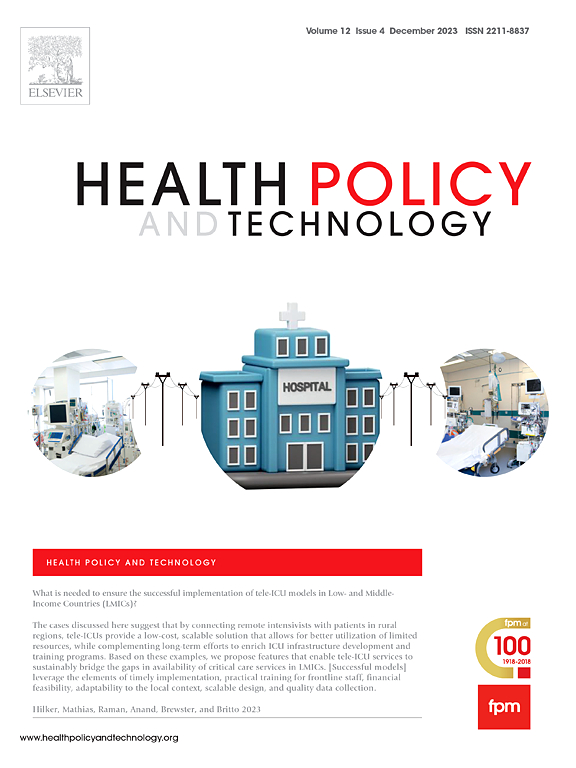将受过国际教育的护士纳入护理教师队伍:护理监管机构的新政策
IF 3.7
3区 医学
Q1 HEALTH POLICY & SERVICES
引用次数: 0
摘要
与注册临床护理人员短缺相比,文献和媒体对护理人员短缺的关注较少。有人可能会问,我们是否没有足够的护理教师来教授和培训学生,谁来承担这个责任?护理领导、研究人员和关键系统合作伙伴应该解决这个关键问题,以制定创新和可持续的政策,减少护理教师短缺。否则,护理师资的短缺会影响护理教育的质量,导致护理席位的减少,这是我们应该避免的,因为我们在未来几年需要更多的护士。本文建议为护理监管机构制定一项名为“非临床学术注册类别”的新政策,以支持具有硕士或博士学位的国际教育护士(IENs)希望为护理教师队伍做出贡献。为了更好地理解这一政策的背景及其好处,本文描述了三个IENs在注册过程中遇到的挑战以及将他们融入劳动力队伍的影响。通过集体和创新的政策,我们可以增强未来护理教师队伍的能力,理性地应对当前的危机。本文章由计算机程序翻译,如有差异,请以英文原文为准。
Integrating internationally educated nurses into the nursing faculty workforce: a new policy for nursing regulators
Nursing faculty shortages received less attention in the literature and media outlets compared to registered clinical nursing staff shortages. One may question whether we do not have enough nursing faculty to teach and train students, who will take that responsibility? This critical question should be addressed by nursing leaders, researchers, and key system partners to develop innovative and sustainable policies that reduce nursing faculty shortages. Otherwise, the nursing faculty shortage would negatively affect the quality of nursing education and lead to a declining number of nursing seats, which should be avoided as we need more nurses in the upcoming years. This paper suggested developing a new policy for nursing regulators, titled “Non-clinical Academic Registration Category”, to support internationally educated nurses (IENs) with master's or doctoral degrees who wish to contribute to the nursing faculty workforce. To better understand the context of this policy and its benefits, the paper described the challenges of the registration process experienced by three IENs and the implications of integrating them into the workforce. Through collective and innovative policies, we can empower the future nursing faculty workforce and rationally respond to the ongoing crisis.
求助全文
通过发布文献求助,成功后即可免费获取论文全文。
去求助
来源期刊

Health Policy and Technology
Medicine-Health Policy
CiteScore
9.20
自引率
3.30%
发文量
78
审稿时长
88 days
期刊介绍:
Health Policy and Technology (HPT), is the official journal of the Fellowship of Postgraduate Medicine (FPM), a cross-disciplinary journal, which focuses on past, present and future health policy and the role of technology in clinical and non-clinical national and international health environments.
HPT provides a further excellent way for the FPM to continue to make important national and international contributions to development of policy and practice within medicine and related disciplines. The aim of HPT is to publish relevant, timely and accessible articles and commentaries to support policy-makers, health professionals, health technology providers, patient groups and academia interested in health policy and technology.
Topics covered by HPT will include:
- Health technology, including drug discovery, diagnostics, medicines, devices, therapeutic delivery and eHealth systems
- Cross-national comparisons on health policy using evidence-based approaches
- National studies on health policy to determine the outcomes of technology-driven initiatives
- Cross-border eHealth including health tourism
- The digital divide in mobility, access and affordability of healthcare
- Health technology assessment (HTA) methods and tools for evaluating the effectiveness of clinical and non-clinical health technologies
- Health and eHealth indicators and benchmarks (measure/metrics) for understanding the adoption and diffusion of health technologies
- Health and eHealth models and frameworks to support policy-makers and other stakeholders in decision-making
- Stakeholder engagement with health technologies (clinical and patient/citizen buy-in)
- Regulation and health economics
 求助内容:
求助内容: 应助结果提醒方式:
应助结果提醒方式:


